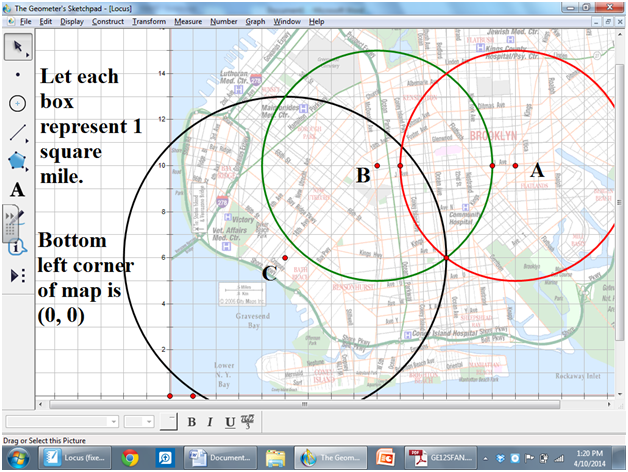Normally, when I used to introduce locus my aim looked like this:
Aim: How do we sketch the locus of points a fixed distance from a point?
This year it looked like this:
Aim: How do cell phone towers determine the location of a customer?
Huge difference, and you can note the difference in the level of engagement the minute students read the aim walking into the room.
Before the break I found a really awesome lesson at Mathalicious.com. The lesson looked at locus, more specifically focused on the locus of points a fixed distance from a point. They really did a great job putting this lesson together. Below is a pic of a part of the lesson I did with my students.
Essentially the lesson first seeks to answer: How many cell phone towers does it take to determine a customer's location?
Students then go through a series of activities involving locus to determine this.
There are three main parts to the lesson but since I was using it to introduce locus, we just focused on that part of the lesson that looks at how many towers are needed to track a persons location. (Although we will probably later do the rest since the whole lesson is rich).
I tried to make the lesson more personal to my students by using a map of Brooklyn instead of the provided map of Albuquerque. This was easy, just copied and pasted a map of Brooklyn to sketchpad and had students download the pre-arranged file off my website.
The lesson is a beauty, I really didn't have to change much. Overall, this really is a great lesson with very good questions. The lesson is also universally accessible, all of my students were engaged and I have the observation report to prove it!
|
1 Comment
With all the new changes now taking place (eg: Common Core) I believe the one that sticks out the most is: Learner-centered environment. It seems to me, that all of these changes seek to create a classroom environment where the student is doing math not watching the teacher do math. So what does a learner centered environment look like in a math class? I think that this is summarized in the 8 standards for mathematical practice: |
AuthorMath teacher at HSSM in NYC Archives
December 2015
Categories |

 RSS Feed
RSS Feed
